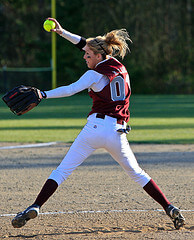During my career, many people have inquired about beginning pitching. How do you start, what do you teach, and when do you progress to more advanced pitching? In the following text, I am going to provide the reader with an overview of my philosophy on beginning pitching.

How do you start?Do we walk before we crawl? Do we run before we walk? Do we sprint before we jog? These principles underlie my philosophy of pitching. Do we pitch at 35, 40, or 43 feet before we pitch at 2, 10 or 15 feet? Absolutely not!The best way to begin pitching is by starting close with three basic drills: Wrist Snap (two-foot distance), X-drill (10 foot distance), and Circle drill (15 foot distance).
Wrist SnapsHave your pitcher begin with her feet perpendicular to the catcher. Isolate the pitching wrist with the opposite hand and cock the wrist back as far as possible. Snap the ball to the catcher with proper four-seam spin and grip. (I recommend gripping the ball with the pads of the fingers at the top of the “C”).
X-Drill
The pitcher’s glove should be pointing at the catcher, the front foot should be at a 45-degree angle toward the catcher with the hips completely open so that her feet are perpendicular to the catcher (should be able to draw a straight line between the toes of each foot, and the catcher), and the ball should be at the 2:00 o’clock position with the back of the hand facing the catcher. She should be able to see the glove and the ball with her peripheral vision. As she drops the glove down toward the hip, the ball should travel toward the catcher and be released at the hip; this is called opposition. Once the ball is released at the hip, allow the hand to follow through naturally to the catcher.
Circle Drill
Same positioning as the X-Drill, but begins with the glove and ball in front of the body. Both hands travel straight toward the catcher; the glove stops, the arm keeps going, opposition, snap the wrist at the hip, and follow through naturally toward the catcher.
As you can see, each drill described above builds upon one another. Also, each drill can be found somewhere in the pitching motion, which I will discuss in the following section. I recommend 30 repetitions of each drill discussed, four-to-five times a week. Work on quality, not quantity.
What Do You Teach?
Once the pitcher has perfected the basic drills, it is time to learn the pitching motion. I separate the pitching motion into three phases, and again, all of the basic drills discussed above can be found in the pitching motion. The pitching motion should be a natural transition from the basic drills, if the basic drills are mastered.
Phase One–Introduction:
This is merely the presentation of the ball to the x-position. Start with the right foot in front of the rubber and the left foot behind the rubber if she is right handed (opposite for left-handed). Some swing both arms back, some slap their thighs, and some pull straight out from the navel area. The approach is simply a personal choice. The only requirements are that the wrist is cocked back, both arms travel toward the catcher, the glove stops, and the arm continues to travel as she takes a step and approaches her x-position.
Phase Two–X-Position (as described in the X-drill)
This is the most important phase because both hips are completely open so that the feet are perpendicular to the catcher, which provides a clear path for the arm to follow straight toward the catcher during opposition. Remember, in this phase, she should be able to draw a straight line between the toes of each foot and the catcher.
Phase Three–Follow-Through
Once the ball is snapped at the hip, allow the arm to naturally travel toward the catcher as she brings the back foot up, even with the front foot. The follow-through phase will leave the pitcher in a good defensive position.
A simple tool: Draw a straight line in the dirt. If your pitcher is right-handed, begin with her right foot on that line for Phase One. In Phase Two, both feet should be on the line, and in Phase Three, the left foot should be on the line (opposite for left-handers). If her feet deviate from these lines, she will experience problems with accuracy and speed, and will eventually develop shoulder problems.
When To Progress to More Advanced Pitching?
I recommend that once the pitcher perfects the basic drills and can throw eight out of ten strikes with accuracy using the pitching motion, the pitcher is ready to move forward to more advanced pitching strategies such as junk pitches.Pitching is an art of basic mechanics. Those who do not master the basic mechanics will struggle with many aspects of advanced pitching.